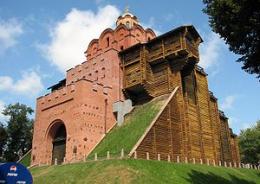|
Articles
 |
|
|
Golden Gate was built in 1037 during the reign of Grand Prince Yaroslav the Wise of Kiev. At that date Kiev was surrounded by high ground ramparts with deep ditches on the outside. Golden Gate was part of this fortification and served as the main entrance to the city - it was a wide arch with combat ground on it, in the center of which white stone church was built. This amazing creation of Old Russian architects was admired by coevals and appalled the enemies by its inaccessibility. In addition to defense purposes Golden Gate had also triumphant nature - foreign ambassadors and distinguished guests were met there, the soldiers were sent off to defend the homeland; under the arches of the gate the prince's squads were returning from crusade. The height of roadway part of gate was 12 m, the width- 6.9 m. The Church of the Annunciation with a gilded dome accomplished the passage. Hence, gate got its name "Gold". In addition to presentation function, elegant building at the time also fulfilled well the defense function - they could not be taken even by the Tatar-Mongols with their Chinese siege engines. Then Tatars invaded to Kiev through Lyadsky gate. But time and wars didn't have mercy on memorial - in the 17th century Golden Gate were half-destroyed. When in 1648, after the Battle of the Yellow Waters the army of Khmelnitsky entered in Kiev, it was walking through the ruins - the remains of two walls with three arches.
In XVII-XVIII centuries authorities tried to repair the gate several times, obviously without much success. At least in 1751, military engineers detected it dangerous to travel and buried it in the shaft. The new entrance to Kiev was dug nearby. It took over 40 years to Kiev to see the Golden Gate again. At the end of the excavations, carried out by the architect Lokhvytsky, only two badly damaged walls came in sight. Having visited Kiev, Tsar Nicholas I ordered to preserve the historical monument. Following his will the walls were pierced and stitched with metal ties, filled with lime, covered with sheets of iron and reinforced with thorough buttresses. To discover the Gate in this building was extremely difficult.
In the middle of 19th century, work was done to clean up and strengthen the ruins. However, masonry, opened to wind and precipitation, continued to deteriorate, causing a constant concern of scientists.
In 1970, it was decided to build a pavilion above the ancient ruins, which would protect it not only from further damage, but also recreated the original image of the monument. Although the possibility of such reconstruction were (and still are) in the shade) – photos of architectural monument of Kiev Rus didn't survive, and assumptions based on the remains of the walls. The opening of the pavilion-reconstruction "Golden Gate" was devoted to the 1500th anniversary of Kiev in May, 1982.
Golden Gate in Kiev is one of the few buildings of Kiev Rus, which have come down to our day. It is included in the UNESCO World Heritage List.
There is metro (subway) near the monument "Golden Gate", and the monument is located in Zolotovorotskaya Square. Golden Gate is in Yaroslav Val Street. It stretches from the Golden Gate to the Lvov Square (area) and reflects the contours of the ancient city wall of the city of Yaroslav, connecting the front entrance in Kiev - Golden Gate and Lviv gate. The old name of the street - Bolshaya Podvalnaya ( Large basement) , from the word "shaft" rather than a "basement" as confirmed by the majority of local residents. Just in few blocks there is Malopodvalnaya Street, origin of its name has the same story.
|